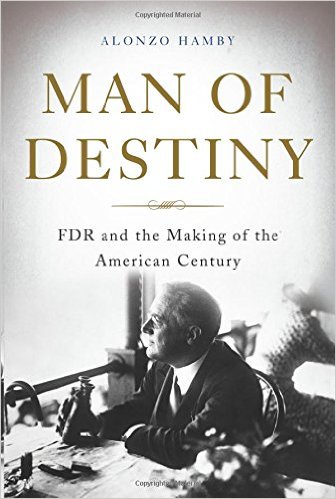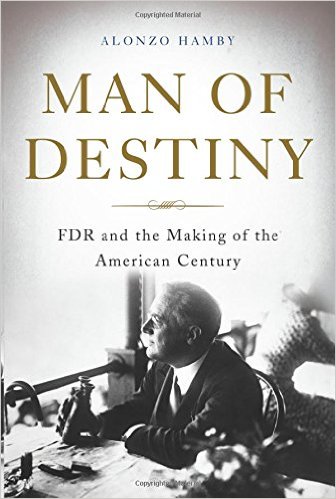
Finest Hour 171
Books, Arts & Curiosities – Churchill’s Friend

March 20, 2016
Finest Hour 171, Winter 2016
Page 45
Review by Mark Klobas
Alonzo Hamby, Man of Destiny: FDR and the Making of the American Century, Basic Books, 2015, 512 pages, $35.00.
ISBN 987-0465028603
 As with Winston Churchill, Franklin Roosevelt is a historical figure about whom there is no end of biographies regularly produced. Alonzo Hamby is the latest contributor to this genre, and he brings to it a long career as a scholar of Roosevelt’s successor, Harry S. Truman, as well as his previous work as the author of an examination of the New Deal within the comparative context of the response to the Great Depression by the other nations of the West. The perspective Hamby brings is reflected in his main thesis about Roosevelt, whom Hamby sees as the man whose efforts in saving liberal democracy during the Second World War brought about the “American century” and the world in which we still live today.
As with Winston Churchill, Franklin Roosevelt is a historical figure about whom there is no end of biographies regularly produced. Alonzo Hamby is the latest contributor to this genre, and he brings to it a long career as a scholar of Roosevelt’s successor, Harry S. Truman, as well as his previous work as the author of an examination of the New Deal within the comparative context of the response to the Great Depression by the other nations of the West. The perspective Hamby brings is reflected in his main thesis about Roosevelt, whom Hamby sees as the man whose efforts in saving liberal democracy during the Second World War brought about the “American century” and the world in which we still live today.
Hamby divides his study of Roosevelt into three parts, consisting of his life before the presidency, the years of his administration devoted to the domestic policies of the New Deal, and his handling of the international crises of the 1930s and the wars that followed. The division represents the trade-off Hamby faced in compressing such a detailed life into 436 pages of text, with the book’s focus on Roosevelt’s twelve years as president coming at the cost of a detailed examination of the fifty years of his life that preceded them. The other major choice Hamby makes is to focus on Roosevelt’s public career, reducing his private life to the background for most of the book. This is understandable given Hamby’s view of Roosevelt’s relationships with most people as defined by political utility rather than true friendship, but it marginalizes the presence in the book of his wife Eleanor to a far greater degree than it should be, given the outsized role she played in his career.
When he reaches the second section of his book Hamby slows his pace and expands his focus, providing a broad account of the development and implementation of the New Deal. While recognizing Roosevelt’s considerable efforts to ease the toll the Depression had taken upon millions of Americans, Hamby is critical of the New Deal overall, viewing it in the end as a barrier to economic recovery both domestically and in the larger global economy as well. Yet the American voters credited his efforts rather than their results, delivering a resounding endorsement of his policies by reelecting him to a second term in 1936. Roosevelt followed this triumph, though, with a series of ill-judged missteps that solidified the conservative opposition to his policies in Congress, and Hamby argues that it was the deteriorating international situation that provided him with a second chance to define his historical reputation.

2025 International Churchill Conference
The prospects for success were not promising. Roosevelt faced the militaristically aggressive regimes in Europe and Asia as the leader of a nation that was strongly isolationist in its sentiments. Despite this, Roosevelt moved towards opposition to Imperial Japan and Nazi Germany, a move that took on added import with the outbreak of war in September 1939. Here Hamby focuses more upon Roosevelt once again, recounting his many personal efforts to prepare the nation for the prospect for war and provide support for the nations fighting Germany and Japan. Among the measures that Hamby describes is the personal relationship that he began building with Churchill, starting with Roosevelt’s personal note to Churchill soon after his return to the Admiralty. Hamby stresses the similarities between the two men, namely their charismatic leadership, inspirational rhetoric, and determination in confronting the Axis powers. The difference he notes was in terms of their ideologies, with Churchill’s belief in imperialism distinguishing him from Roosevelt’s unalloyed belief in liberal democracy.
The disagreement between the two men on this matter, however, was minor compared to their shared goal of defeating the Third Reich. Hamby credits Roosevelt with making bold gestures given the context of American public opinion, providing aid to Britain within the limits of what was politically possible. With the formal entry of the United States into the war in December 1941, the informal partnership became a formal alliance, one that would survive policy disagreements and Roosevelt’s occasional twitting of the prime minister. Roosevelt hoped to develop a similar personal connection with Joseph Stalin as well, but Hamby is far more critical of the President’s efforts here, seeing him as more accepting of the Soviet leader’s ambitions than Truman would be.
Overall Hamby’s book provides a capable survey of Roosevelt’s public life and political achievements. While there is little that is new within its pages (and an unfortunate perpetuation of the stale misconception about Churchill’s level of alcohol consumption), his command of his material is assured and his judgments clear. Readers seeking an introductory overview of Roosevelt’s career will find this biography fits the bill most satisfactorily, though those who desire a deeper understanding of such subjects as the Roosevelt-Churchill relationship should plan on supplementing it with more specialized works.
Mark Klobas teaches history at Scottsdale College in Arizona.
Subscribe
WANT MORE?
Get the Churchill Bulletin delivered to your inbox once a month.



